Institutionalization Strategies
This section shares strategies for implementing staff and administrator training for the purpose of creating campus services that are accessible to all students. The information is applicable to registration, recruiting and admissions, financial aid, housing and residential life, computer labs, learning/tutoring centers, distance learning, libraries, career services, and other student service units. Universal design should be the goal. This means that services are available to students with a broad range of characteristics with respect to age, gender, socioeconomic status, English proficiency, learning style, and race/ethnicity. Accessibility can be included in other campus diversity efforts. Ideas for promoting systemic change, as well as for measuring impact, are included.
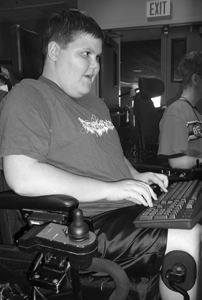
Introduction
Creating a climate that fosters equal access for students with disabilities may require systemic change on your campus. How to best institutionalize change depends on characteristics of your school. Consider the size of the organization, previous exposure of staff to these issues, programs offered, resources available, administrative structure, current availability of training and support for staff and administrators, and mechanisms to monitor compliance. Review the policies in place that pertain to accessibility and how well they are articulated and enforced.
As you work toward making your campus more accessible, regularly remind yourself of the importance of your work. Human-rights and quality-of-life issues are at stake. Your efforts can result in greater academic and career success for the students you serve even if changes are small and slow in coming. Keep your ultimate goal of equity in mind and persist in reaching it.
No single solution will apply to all campuses. However, you can learn from the experiences of others. Included in this section are general guidelines, promising practices, and successful experiences from two-year and four-year postsecondary institutions nationwide. This advice is given by administrators and support staff from institutions of higher education who are part of the DO-IT Admin Team that created these training materials. They represent postsecondary institutions with a variety of characteristics from twenty-three different states. The strategies are organized into six areas: needs assessment, teamwork, administrative support, professional development, promotion, and evaluation. For details about a specific example, contact the appropriate DO-IT Admin team member listed in the Project Team section near the beginning of this notebook.
Needs Assessment
Conduct a needs assessment. Administer surveys and/or conduct focus groups with students, administrators, and student service staff to identify problems and develop solutions regarding access to campus services. A needs assessment can help you share knowledge, prioritize issues, develop goals, and brainstorm strategies. Student service staff members can share their experiences and needs for resources and training. Administrators can provide insight into current policies, suggestions for developing new policies, and identification of possible barriers to implementing change. Students can share their personal experiences and observations regarding the accessibility of services and programs on your campus.
Following are descriptions of needs assessments conducted by institutions across the country.
Example: Focus Groups
Through the DO-IT Admin project, focus groups of student service staff members, administrators, and students with disabilities were conducted on campuses nationwide. The focus groups with staff and administrators examined experiences working with students with disabilities, knowledge and level of satisfaction with campus resources, and suggestions for professional development methods and content. Students shared their campus experiences and made recommendations for the delivery of professional development to staff and administrators of student service units. Focus group results, along with a literature review, guided the creation of the content and format of the professional development materials described in this publication and available in The Student Services Conference Room.
Example: Survey of Staff
The University of Kentucky conducted an online survey of university administrators and auxiliary service personnel to assess activities, practices, and resources.
Example: Meetings
Disability support staff on some campuses met with groups of staff, administrators, and/or students from a specific service unit to learn about needs, experiences, and problems unique to that department. In order to solicit the most honest responses, the three groups—staff, administrators, and students with disabilities—met separately. Actions were taken in response to the needs identified.
Example: Response to Needs Identified by Students
At the University of Minnesota Duluth, students found that the only accessible path to a music classroom and practice hall located on the basement level required the use of a freight elevator. The pathway to the classroom also required going through a performance theater, a dark hallway to the elevator, storage space, and another poorly lit area. With cooperation from the theater department, the storage space was cleared, and a path through the area was created. With the help of facilities management, the lighting and door pulls were improved. Staff of the music department instituted a practice of walking the accessible path to class each day to ensure that lights were on and pathways unblocked. While these temporary measures were instituted, students sought and received approval from the chancellor to fund a passenger elevator that made the entire building more accessible.
Teamwork
Know your organization and stakeholders. Who are the leaders and policy makers on your campus? Who are other stakeholders? How can stakeholders become involved in activities and/or in advisory capacities? Who is (or should be) involved in the stages of planning disability-related awareness activities, training, support, policy and procedure development, implementation, compliance, and evaluation? How does policy get formed? Where does funding come from, and who decides what it is used for? What are the barriers to change? Who promotes change? Who implements change?
Include all stakeholders in developing student service unit action plans for improving accessibility and creating an inclusive climate for students with disabilities. Consider the following as potential stakeholders on your campus when it comes to making facilities, programs, services, and information resources accessible to students with disabilities:
- students
- faculty
- administrators student service staff
It is easier to garner resources, face opposition, and maintain your enthusiasm and direction as part of a group. Look for allies everywhere. Some may be found in these places:
- disability services offices
- faculty and staff development or training centers
- ADA compliance offices
- equity and diversity committees
- computing services
- teaching assistant organizations
- physical plant or facilities units
- disabled student organizations
- disability services offices on nearby campuses
- community and governmental service providers
Organize yourselves into a team. Put together a committee to make recommendations and to design and implement professional development for administrators and staff that will result in a more inclusive campus. Not only is there strength in numbers, but coalitions also result in more ideas and more resources to implement plans. Work together as a team to consider and tailor the suggestions in this publication to the unique needs of your campus.
Ensure that campus recruiters, admissions staff, financial aid, personnel, staff associations, academic counselors, computer labs, and other campus units are knowledgeable about campus resources available to faculty and staff and to students with disabilities. Let student support units and student organizations know of services. Suggest ways they can contribute to your efforts. Ask to be included on regular meeting agendas. Inform these groups about legal issues, accommodation strategies, and campus resources.
Example: ADA Task Force
When the Americans with Disabilities Act of 1990 (ADA) was passed, the University of Minnesota Duluth (UMD) developed an ADA Task Force to ensure that UMD was in compliance. The Access Center (which provides disability-related services) worked with the chancellor to identify a core group of people to assess the needs of the campus. When the initial assessment of the ADA Task Force was complete, the value of supporting ongoing assessment and recommendations was recognized by both staff and students. Task force members now represent all units on campus, from collegiate units and facilities management to students, information technology, and housing. Representatives are appointed by heads of departments. Access Center staff are ex officio members. The task force continues to identify and resolve access issues on campus.
Example: Disabled Student Programs and Career Services
As a result of a job placement grant, the Disabled Student Programs & Services (DSP&S) office at Mt. San Antonio College had matching funds that were available for use. A great need for job placement services for students with disabilities existed; however, the matching funds could only support one job development position and a small percentage of a second. The campus Career Services office also happened to be understaffed at the time, and staff were looking for ways to provide more services on a limited budget.
The job developers from DSP&S collaborated with staff in Career Services and convinced college administrators to pick up the remaining cost of the second position and transfer both DSP&S job development positions to Career Services. This resulted in a positive solution for all parties involved. Career Services gained two employees, DSP&S retained the valuable and specialized job placement services for students with disabilities within a centralized model, and the college was able to retain two excellent, experienced employees.
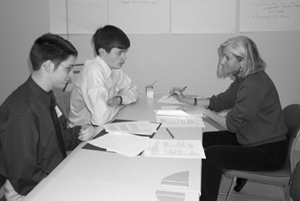
Administrative Support
Gain the attention and support of the administration. Let key administrators know about campus needs and your efforts and accomplishments. Encourage the administration to distribute written notices across campus that describe the policies, guidelines, and practices that promote full access to all campus offerings to students with disabilities. Garner support from faculty, departments, and service units campus wide; create linkages and collaborations. Meet with administrators to elicit suggestions regarding how best to reach new employees, student employees, and part-time or temporary staff.
Example: Evaluating Policies and Procedures
Southwest Missouri State University Disability Services (UDS) carefully evaluated their system wide policies and procedures regarding disability and discovered many inconsistencies. They began to work with Student Affairs, Academic Affairs, Administrative Services, and the president to streamline university policies on disability. From these discussions, a few significant developments occured:
- UDS gained tremendous support from upper administration. Once many of these individuals saw the positive impact, they were open to looking at training programs and additional supports for faculty and staff.
- UDS rewrote its statement of commitment to students with disabilities and to diversity as a whole. Once again, this forced administrators to revisit related issues.
- Campus catalogs, departmental statements, and other campus publications were modified to include the new statement of commitment to students with disabilities.
Example: Web Publishing Policy
The University of Wisconsin-Madison developed a policy governing web accessibility (www.wisc.edu/policies/wwwap) to ensure that individuals with disabilities have access to web-based material originating on campus. Informative letters were sent to all faculty and staff by the Vice Chancellor for Legal and Executive Affairs and the university's Americans with Disabilities Act coordinator.
Example: Funding and Cooperation
At the University of Minnesota Duluth, the director of Information Technology Systems and Services (ITSS) sets aside a portion of the budget to ensure that computers and computer labs are accessible to students with disabilities. One staff person from the Access Center works with a representative from ITSS to plan for and purchase adaptive software and hardware to meet student needs. It has been found that much of the accessible software and hardware is beneficial to other students on campus. Screen enlargement software, for example, has helped many students avoid eyestrain when working on computers. Following the model set up by ITSS, other departments are working with the Access Center to project funding requirements to assure accessibility.
Example: Departmental Support
The University of Wisconsin-Madison formed a partnership with Macromedia to develop accessible multimedia, specifically Flash™. Several department representatives collaborated on this project. The same university group, eCurb Cuts, identified training needs for web developers to retrofit inaccessible web pages. The training was piloted and is now available for campus computer support staff via a "train-the-trainer" model. The trained support staff teach others within their colleges, schools, and departments.
Example: Sharing Accomplishments with Administrators
The DO-IT Admin project director drafted a letter that was then tailored to specific campuses and mailed to key administrators selected by team members. The letter emphasized that their selection as a member of the DO-IT Admin Team recognized their knowledge, experience, mission, accomplishments, and motivation to address the issue of helping campus units more fully include students with disabilities in their services and programs. The importance of the project was also emphasized.
Example: Campus Support
On some campuses, written notices are distributed yearly through the president's or provost's office. These notices describe the institution's commitment to diversity, including the full inclusion of students with disabilities in all programs and services.
Example: Shared Responsibility
At the University of Wisconsin-Madison, each department has appointed an Access and Accommodation Resource Coordinator to help faculty, staff, and students address issues of access and accommodation in instructional settings. Collaborative disability-related awareness and training events are coordinated through these department representatives on a regular basis.
Example: Campus Committee Involvement
At Santa Fe Community College, a representative from the Disabled Student Services (DSS) office serves on the Financial Aid Appeals Committee. Serving on campus committees increases the visibility of DSS office staff, builds trust, and provides advocacy for students with disabilities at this level of campus administration.
Example: Funding Accommodations
At Hunter College, many students with disabilities were not participating in government and student body activities because they were not accessible. As a result, a small portion of student fees was appropriated for accommodations for students with disabilities in student activities.
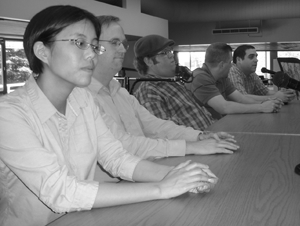
Professional Development for Administrators and Support Staff
Find out how your campus student service staff members and administrators organize themselves and arrange to be placed on meeting agendas. Let them know about your goals and activities in creating accessible services, as well as how their organization can help. Meet with groups regularly to discuss issues and activities.
Format professional development offerings to match the customs, organizational structure, and climate of your campus. Some institutions are well served by presentations at regular office or departmental meetings where the expectation is that all staff members will attend. This approach brings staff development regarding disability issues to a broad audience and requires a minimum amount of coordination on the part of the presenter.
Tailor training to specific audiences. Provide many options for staff and administrators to learn how to create accessible facilities, services, and information resources for students with disabilities. Options include the following:
- short orientations to legal issues, accommodation strategies, and campus resources at departmental meetings
- tailored presentations to address issues of special importance to a specific service unit
- comprehensive workshops offered through centralized staff training programs
- accessibility modules integrated into mainstream training sessions (e.g., accessibility guidelines incorporated into web page development classes)
- resources tailored to staff and administrators available on the World Wide Web
- instructional videos presented on cable television
- distance learning training options provided on the Internet
- short publications mailed periodically to staff and administrators that highlight legal issues, universal design, accommodation strategies, and campus resources
Example: Accessibility in Web Training
Many campuses offer workshops to students and staff on the development of web pages. Some include a section on accessibility in each of the courses. The video and handout included in this notebook, World Wide Access: Accessible Web Design, can be used for this purpose.
Example: Computer Staff Training
On some campuses, staff who are knowledgeable about accessibility work with the staff at computer labs and technology support centers to assure that their facilities, software, websites, and hardware are accessible to students with disabilities. In addition, they make sure staff know what resources are available when special needs arise. Several videos and handouts in the Technology and Universal Design area of the DO-IT website at www.washington.edu/doit can be used in this training. They include:
- World Wide Access: Accessible Web Design
- Working Together: People with Disabilities and Computer Technology
- Equal Access: Computer Labs
- Working Together: Computers and People with Learning Disabilities
- Working Together: Computers and People with Sensory Impairments
- Working Together: Computers and People with Mobility Impairments
Example: Mandatory Training
The Administrative Council at Southwest Missouri State University passed a mandatory six-hour training session for all faculty and staff regarding sexual harassment, diversity (including disability), and effective communication. A full-time trainer was hired to coordinate this effort.
Example: Orientation for New Staff
The administration of Seattle Central Community College in Washington State requires new employees to attend a full-day orientation that includes a brief presentation by the Disability Support Services Office on the ADA and accommodation issues. Similar practices are implemented on many other campuses around the nation.
Example: Outreach to New Staff
Some insert brochures in packets that are given to new staff members and deliver presentations at orientations for new employees.
Example: Academic Advisor Training
Southwest Missouri State University has a Master Advisor program to train campus advisors. Disability services staff deliver a presentation and participate in this one-and-a-half-day training session.
Example: Support Group
The University of Washington created an AccessibleWeb user group. This support group of webmasters and administrators meets once a month and communicates on an electronic discussion list regarding issues related to making their websites accessible. A similar online discussion group is open to people nationwide. Consult AccessDL for information on how to join.
Example: Printed Resources
Campuses nationwide have sent printed copies of the brochure Equal Access: Universal Design of Student Services to campus service staff and administrators. This brochure can also be used at presentations for specific student service offices and departments. A reproducible copy of this handout is included in the back pouch of this notebook.
Example: Survey Staff
One four-year college worked with a community college to put together a training session for the community college. All faculty and staff were required to attend. A questionnaire was sent out ahead of time to identify issues of concern, and issues identified by respondents were addressed during the training session.
Example: Publicize Accomplishments
Some organizations identify local papers, radio stations, and television channels and then send press releases that showcase their efforts to make their campuses more accessible to students with disabilities.
Example: One-to-One Training
Giving individualized assistance to faculty and staff regarding questions on providing accommodations to students with disabilities on an as-needed basis has been proven to be very effective on many campuses. Sometimes this one-to-one assistance can be provided by other staff who have received in-depth "train-the-trainer" instruction.
Example: Distance Learning Course
An email-based distance learning course was created by the DO-IT Admin project. A series of email messages with content and discussion questions can be sent to a group of new employees to orient them to disability-related access challenges and solutions. This course can be tailored to any campus and can be found in the Resources for Trainers and Administrators area of The Conference Room.
Example: Campus Partnerships and Training
At Seton Hall University the Disabled Student Services (DSS) office established liaisons with staff in housing, libraries, information technology, financial aid, and so on by inviting them to incoming freshman orientation for students with disabilities. These departments were brought in to talk to students about services in their area; however, the students asked many important questions that were often disability-specific. The staff from these departments realized they needed more information and training about the needs of students with disabilities, and DSS now does regular professional development for all of these groups on campus.
Example: Staff and Administrator Website
The Student Services Conference Room and The Board Room are websites that are linked from many campus disability services and departmental websites to provide student service staff and administrators with an overview of rights, responsibilities, accommodation strategies, universal design strategies, and resources. These websites can be found at https://www.washington.edu/doit/programs/accesscollege. Consider linking to them.
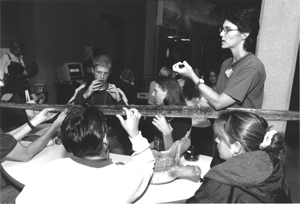
Training for Students
Consider ways to get disability-related topics into course offerings on your campus. Locate existing courses on education, engineering, diversity, computing, or other topics where disability issues should be included but are not. Meet with instructors and offer suggestions, videos, printed publications, and speakers to help them integrate this topic into existing classes.
Example: Distribution List
Electronic distribution lists are excellent vehicles for sharing information, discussions, and common concerns and providing immediate feedback on ideas, opinions, or problems. Individual discussion groups can be set up for students with disabilities, departmental administrators, and staff members.
Example: Website for Students with Disabilities
DO-IT hosts a website called The Student Lounge that can be helpful for prospective and current students with disabilities. Consider linking your website to https://www.washington.edu/doit/programs/accesscollege, as well as providing campus-specific information on your site, such as the location of tutoring centers.
Example: Peer Advisors
Santa Fe Community College has developed a peer advisement program in their Enrollment Center. As part of the peer advisement program, interested peer advisors spend one semester in the Disabled Student Services (DSS) office. In the DSS office they serve as paraprofessional case managers and advise students on issues such as course loads and scheduling. This provides the peer advisors with an opportunity to get to know the students with disabilities and raises their awareness and understanding of access and accommodation needs. Additionally, they can apply this knowledge when they return to the advising office.
Promotion
Raise the visibility of campus disability support services. Create a publication and a website describing procedures and services of the office that supports students with disabilities. Increase the number of disability-related presentations on campus. Work with your campus and community press to get the word out. Issue regular press releases about disability-related topics and events to campus newspapers. Make disability-related resources prominent on the campus World Wide Web home page, and encourage campus units to link to your site.
Many web pages for the offices of support services for students with disabilities nationwide include a link to AccessCollege at https://www.washington.edu/doit/programs/accesscollege. This page links to The Student Services Conference Room, The Board Room, The Faculty Room, and The Student Lounge websites. The DO-IT Admin team created web resources with searchable Knowledge Bases that are useful for any campus.
Example: Accessibility Awards
The University of Washington gave a campus unit an accessibility award for extraordinary efforts in making its electronic resources accessible to students and staff with disabilities. An engraved plaque was presented along with other technology-related awards at a "Biztech Showcase"event, where faculty and staff attended exhibits and presentations on informative technology.
Example: Accessible Web Awards
Ohio State University gives awards to departments that produce the most accessible web pages. Recipients are honored with plaques at a special reception.
Example: Marketing
At Southwest Missouri State University, a marketing plan to promote disability awareness was developed with the help of the marketing department on campus. The plan included the following initiatives:
- Everything is centered around the theme "You Can," with a related logo.
- New faculty, staff, and student brochures and a new website were created.
- Signage that included contact information for the support of students with disabilities was placed in each departmental office.
- A display board utilizing the "You Can" theme was created and displayed at the New Student Festival, orientation sessions, and other activities.
- Departmental staff wore T-shirts with the "You Can" logo on numerous occasions.
- Staff purchased and distributed magnets, screen sweeps, and stress balls with the "You Can" logo.
- Staff are working with the organizational psychology department on campus to develop a high-energy 5- to 7-minute "infomercial" about campus programs that support students with disabilities to show on the campus television station and in classes.
Example: Online Resources
The University of Wisconsin-Madison's website (www.wisc.edu/policies/wwwap) was developed by the Division of Information Technology and has become a major resource for the campus. In addition to campus policy resources, frequently asked questions, examples of accessible web pages, and online tutorials and resources are posted.
Example: Model Web Page
The Access Center at the University of Minnesota Duluth makes sure that its website is a model of accessible design. As other faculty and staff learn to create accessible web pages, the Access Center's page is used as an example.
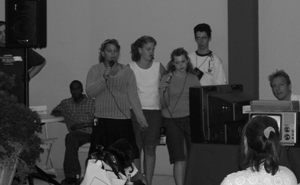
Events
Create and promote disability-related events, and include people with disabilities in other events on campus. Bring music, dance, art, poetry, and speakers that celebrate and/or increase awareness of the wide range of abilities and disabilities in our society. Many campuses have funding for cultural events that increase awareness of underrepresented groups; tap into these resources. Recruit speakers with disabilities to be part of regular campus programs. A presenter who happens to be blind sharing her research on climate trends as part of a campus lecture series may be more effective in changing attitudes about the capabilities of people with disabilities than a lecture on the topic.
Share expertise by presenting at conferences. Submit proposals to present at campus events and local, regional, and national conferences. DO-IT Admin videos, handouts, and visuals included in this notebook can be used for your presentation. This can also be found various Resources sections of The Conference Room.
Example: Disability-Related Events
Each semester, the University of Wisconsin-Madison holds an "Accessibility Series" as part of the Technology Accessibility Program. The series attracts faculty, administrators, and support staff. Follow-up resources are posted on a website. The Accessibility Series is a collaboration of several departments, including the Department of Learning Technology and Distance Education (LTDE), McBurney Disability Resource Center, New Media Centers (NMC), Center for Biology Education (CBE), College of Letters and Science Learning Support Services (LSS), DoIT Media and Communications Technology (MCT), and DoIT Platform and Operating Systems Technology (POST).
Example: Disability Awareness Day
The student group "Access for All" at the University of Minnesota Duluth works with the Access Center to sponsor a yearly disability awareness program. Administrators, faculty, and students are invited. A bulletin board by the Learning and Resource Center also prominently displays disability-related information. The group is advised by a staff person from the Access Center.
Example: Joint Campus Events
The University of Wisconsin-Madison and Madison Area Technical College jointly hosted a spring collaborative ADA Global Horizons Series, which included a keynote speaker. The focus of the event was on learning disabilities.
Example: Sports Events
The Access Center staff at the University of Minnesota Duluth work with the Recreation Sports people on campus, along with two nonprofit organizations, Courage Center and North County Independent Living, to sponsor a Disabled Sports Event. Teams and instructors for wheelchair basketball, wheelchair floor hockey, wheelchair rugby, and goal ball provide opportunities for people with and without disabilities to play. Plans are underway to create a sled hockey team and to sponsor a tennis tournament for participants with disabilities. The UMD student group "Access for All" helps publicize these events.
Example: Interpreter Services
Some disability services offices work with campus drama departments to have at least one of each of their performances interpreted by sign language interpreters and to publicize these offerings in promotional materials.
Create electronic discussion lists to support dialog. Create a discussion list to develop awareness of legal issues, accommodation strategies, resources, or events. Each month start a new dialogue (e.g., "Is your web page accessible to people who are blind?"). Encourage staff from human resources, the physical plant, admissions, disabled student services, and other campus services to join the list.
Example: Technology Issues Listserv
The University of Wisconsin-Madison Division of Information Technology developed a discussion list to address a variety of technology issues. Accessibility issues quickly surfaced and generated lively discussions and information sharing.
Example: Conference Presentations
National conferences at which DO-IT Admin team members have presented include the Annual Conference on Distance Teaching and Learning (https://dtlconference.wisc.edu/), CSUN's conference on Assistive Technology, Association of Higher Education and Disability (AHEAD), National Association of Student Personnel Administrators (NASPA), American Association of Higher Education (AAHE), American Association of Community Colleges (AACC), and American Society of Higher Education (ASHE). Presentation titles include the following:
- "Making Distance Learning Courses Accessible to Everyone"
- "Strategies for Making Campus Services Accessible to Everyone"
- "Accommodating Students with Learning Disabilities"
- "Overview of Adaptive Technology for Students with Disabilities"
- "Accommodating Students with Psychiatric Disabilities"
- "Legal Issues Regarding Students with Disabilities"
- "Helping Students with Disabilities Transition from Two- to Four-year Schools"
- "Accessible Web Design"
- "Web Accessibility Policies and Practices in Higher Education"
- "Universal Design in Higher Education"
Example: Outreach to High School Students
Access Center staff at the University of Minnesota Duluth have been regular participants and planners of a yearly transition fair for high school juniors and seniors called "Rocketing into the Future." They also sponsored their own workshop for college-bound high school juniors and seniors called "Try-It." The workshop featured opportunities to try out adaptive hardware and software available on campus and to learn about Access Center services.
Funding
Consider outside sources of funding. Check if there are general campus or external state funds available for presentations, outreach services, and other ways for building your program.
Connect accessibility compliance with resources. Establish policy that requires faculty to comply with access issues to qualify for funding of special centrally funded projects.
Example: Minigrants
Some campuses have obtained funds to develop minigrant programs to provide assistance to develop accessible web pages, employ principles of universal instructional design, and/or develop accessible online courses.
Example: Community Funds
The "Try-It" workshop sponsored by the Access Center at the University of Minnesota Duluth was made possible by funding from a local community foundation. After submitting its final report, the Access Center was informed that the foundation was interested in funding additional projects that fit its guidelines.
Example: Accessibility Requirements
On one campus, policies were adopted that require faculty members and staff who receive special funds to develop distance learning courses to meet accessibility standards. As a result, all funded distance learning courses are accessible to students with disabilities, and faculty participants learn to develop accessible web pages.
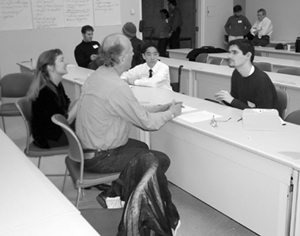
Network with External Organizations
Develop a regional model with a set of consistent practices. Work collaboratively and individually with postsecondary institutions in your state to help each develop and employ appropriate training strategies, policies, and procedures. Utilize the web and electronic discussion lists to promote communication between faculty and staff from postsecondary institutions across the state. Create a summary sheet of intake and documentation requirements for all state schools, and standardize them if possible.
Example: Regional Support Group
The Access Center at the University of Minnesota Duluth was instrumental in developing a network of postsecondary institutions from the northern part of Minnesota and Wisconsin called the Northern Bridge. The group meets two to three times a year, with different colleges hosting the meeting. A planning committee helps set programs and agendas. The group has been a great resource for new service providers and a good network for those in continuing positions.
Example: State Distribution List
The University of Washington hosts the Internet-based distribution list for postsecondary offices that provide support to students with disabilities in Washington State and related organizations. List members share policies and procedures and discuss issues of common interest. DO-IT provides technical support and adaptive technology, accessible web design, accessible distance learning, and other topics of interest to the group.
Evaluation
Measure the impact of your activities. Although it is difficult to come up with measures that show that your efforts have resulted in greater course completion, higher grades, and more diplomas for students with disabilities, it is still worth the effort to collect statistical data and feedback from stakeholders. Participants in presentations can be surveyed, focus groups can be conducted, and yearly enrollment, retention, and graduation figures can be collected and compared.
Example: Document Services Provided
The Access Center at the University of Minnesota Duluth has been involved in a quality review project sponsored by the Vice Chancellor of Academic Support and Student Life. As part of the project, the Access Center has been keeping figures on daily activities with a "scoreboard" shared with the other units under the vice chancellor. Through this process, the Access Center has been better able to document the numbers of students they serve and the services they provide.
Example: Training Evaluation
DO-IT Admin Team members developed long and short evaluation forms titled "Presentation Evaluation." Feedback is used in preparing future presentations. These forms can be found in the Presentations section of this notebook. Other campuses are welcome to use these forms to evaluate their presentations.